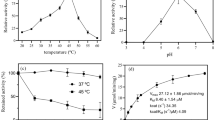Abstract
The chemical nature and spatial arrangements of exopolymers in a degradative biofilm community were studied using a panel of fluorescein isothiocyanate– and tetramethyl rhodamine isothiocyanate–conjugated probes. Image analysis and dual channel imaging, in conjunction with scanning confocal laser microscopy, allowed detection and quantification of lectin binding to a variety of glycoconjugates. Relative abundance of these components varied between 0 and 67% of biofilm area at any depth. Lectin binding sites were distributed nonuniformly, both horizontally and vertically, within the >30-μm thick biofilms when the herbicide diclofop methyl was provided as the sole carbon source. A more uniform distribution of lectin binding sites was formed by the same biofilm community, when grown on a labile medium. Diclofop and its metabolites accumulated in extracellular polymers when biofilms were grown with diclofop as the sole source of carbon and energy, but not in the presence of the labile carbon source. There was a nearly 1:1 correspondence between the distribution of regions that accumulated diclofop (and other chlorinated ring compounds) and regions with binding sites for the α-l-fucose-specific Ulex europaeus Type I lectin. These regions also bound polyanionic and cationic fluor-conjugated dextrans, and a hydrophobic-specific dye, demonstrating the nonuniform distribution of charged and hydrophobic regions in the biofilm matrix. Hydrolytic enzymes, some of them selected for their specificity against residues identified by the lectin assay, had no effect on either structural integrity or diclofop binding. The distribution of diclofop binding, lectin binding, and charged regions observed in these biofilms indicated a degree of spatial organization and differentiation within the biofilm community. In addition, based on cell morphology and fluorescent gram reaction, these regions were primarily associated with one community member, a Bacillus coagulans strain.
Similar content being viewed by others
Author information
Authors and Affiliations
Additional information
Received: 1 April 1997; Accepted 9 July 1997
Rights and permissions
About this article
Cite this article
Wolfaardt, G., Lawrence, J., Robarts, R. et al. In situ Characterization of Biofilm Exopolymers Involved in the Accumulation of Chlorinated Organics. Microb Ecol 35, 213–223 (1998). https://doi.org/10.1007/s002489900077
Issue Date:
DOI: https://doi.org/10.1007/s002489900077




